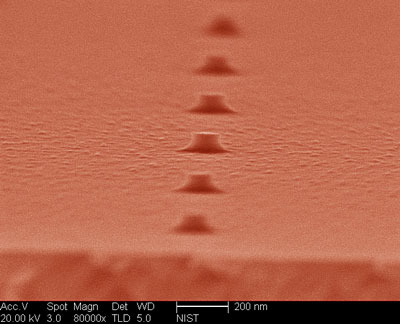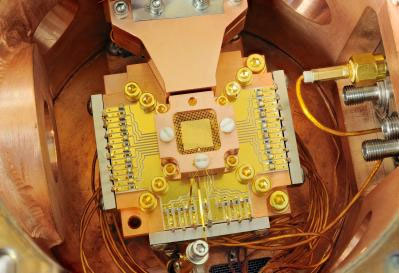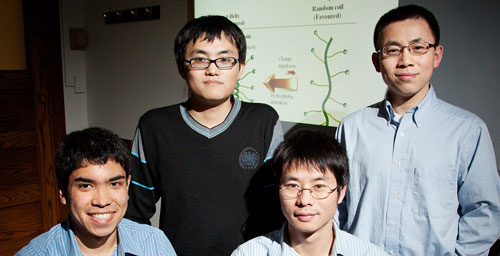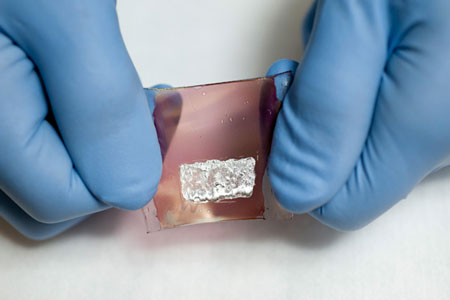Producing clean water in an emergency
McGill researchers develop a new and inexpensive way of filtering water using silver nanoparticles.
Feb 23rd, 2011
Read more
McGill researchers develop a new and inexpensive way of filtering water using silver nanoparticles.
Feb 23rd, 2011
Read more Like snowflakes or fingerprints, no two quantum dots are identical. But a new etching method for shaping and positioning these semiconductor nanocrystals might change that. What's more, tests at the National Institute of Standards and Technology (NIST) confirm that etched quantum dots emit single particles of light (photons), boosting prospects for powering new types of devices for quantum communications.
Like snowflakes or fingerprints, no two quantum dots are identical. But a new etching method for shaping and positioning these semiconductor nanocrystals might change that. What's more, tests at the National Institute of Standards and Technology (NIST) confirm that etched quantum dots emit single particles of light (photons), boosting prospects for powering new types of devices for quantum communications.
Feb 23rd, 2011
Read more Physicists at the National Institute of Standards and Technology (NIST) have for the first time coaxed two atoms in separate locations to take turns jiggling back and forth while swapping the smallest measurable units of energy. By directly linking the motions of two physically separated atoms, the technique has the potential to simplify information processing in future quantum computers and simulations.
Physicists at the National Institute of Standards and Technology (NIST) have for the first time coaxed two atoms in separate locations to take turns jiggling back and forth while swapping the smallest measurable units of energy. By directly linking the motions of two physically separated atoms, the technique has the potential to simplify information processing in future quantum computers and simulations.
Feb 23rd, 2011
Read moreScientists at the Emory Vaccine Center have designed tiny nanoparticles that resemble viruses in size and immunological composition and that induce lifelong immunity in mice. They designed the particles to mimic the immune-stimulating effects of one of the most successful vaccines ever developed - the yellow fever vaccine.
Feb 23rd, 2011
Read moreScientists are reporting development of an advanced lithium-ion battery that is ideal for powering the electric vehicles now making their way into dealer showrooms. The new battery can store large amounts of energy in a small space and has a high rate capacity, meaning it can provide current even in extreme temperatures.
Feb 23rd, 2011
Read moreSTC selected by SPAWAR to build innovative sensor systems for U.S. military intelligence gathering, by EPRI to develop groundbreaking wireless sensor network to monitor efficiency of power generation.
Feb 23rd, 2011
Read more Researchers have developed a simple method of making short protein chains with spiral structures that can also dissolve in water, two desirable traits not often found together. Such structures could have applications as building blocks for self-assembling nanostructures and as agents for drug and gene delivery.
Researchers have developed a simple method of making short protein chains with spiral structures that can also dissolve in water, two desirable traits not often found together. Such structures could have applications as building blocks for self-assembling nanostructures and as agents for drug and gene delivery.
Feb 23rd, 2011
Read moreThe Pittcon 2011 Exposition, which takes place March 14 - 17, at the Georgia World Congress Center, Atlanta, Georgia, will include 978 exhibitors (count as of February 15) that provide products, services, and support for all facets of laboratory operations in the industrial, academic, and government sectors.
Feb 23rd, 2011
Read more A University of Sydney professor is at the forefront of cutting edge work creating complex and beautiful molecular structures that, until recently, could only be made at a life-sized scale.
A University of Sydney professor is at the forefront of cutting edge work creating complex and beautiful molecular structures that, until recently, could only be made at a life-sized scale.
Feb 23rd, 2011
Read more Ultrasensitive electronic skin developed by Stanford researcher Zhenan Bao is getting even better. Now she's demonstrated that it can detect chemicals and biological molecules, in addition to sensing an incredibly light touch. And it can now be powered by a new, stretchable solar cell she's developed in her lab, opening up more applications in clothing, robots, prosthetic limbs and more.
Ultrasensitive electronic skin developed by Stanford researcher Zhenan Bao is getting even better. Now she's demonstrated that it can detect chemicals and biological molecules, in addition to sensing an incredibly light touch. And it can now be powered by a new, stretchable solar cell she's developed in her lab, opening up more applications in clothing, robots, prosthetic limbs and more.
Feb 23rd, 2011
Read moreThe Institute of Nanotechnology (IoN) has just returned from a successful mission to Nanotech 2011 in Tokyo. Together with the Nanotechnology KTN, IoN took key UK SMEs to Japan last week as part of International NanoMicroClub (INMC) initiative.
Feb 23rd, 2011
Read moreIn an advance that could improve battlefield and trauma care, scientists at Albert Einstein College of Medicine of Yeshiva University have used tiny particles called nanoparticles to improve survival after life-threatening blood loss.
Feb 22nd, 2011
Read moreResearchers from Purdue University has reproduced portions of the female breast in a tiny slide-sized model dubbed "breast on-a-chip" that will be used to test nanoparticle-based approaches for the detection and treatment of breast cancer. The model mimics the branching mammary duct system, where most breast cancers begin, and will serve as an "engineered organ" to study the use of nanoparticles to detect and target tumor cells within the ducts.
Feb 22nd, 2011
Read moreBy replacing a chemical group in the macromolecule, researchers have found a way to bypass RNase and create stable three-dimensional configurations of RNA, greatly expanding the possibilities for RNA in nanotechnology.
Feb 22nd, 2011
Read moreRice University bioengineers and physician-scientists at Baylor College of Medicine and Texas Children's Hospital have successfully destroyed tumors of human brain cancer cells in the first animal tests of a minimally invasive treatment that zaps glioma tumors with heat. The tests involved nanoshells, light-activated nanoparticles that are designed to destroy tumors with heat and avoid the unwanted side effects of drug and radiation therapies.
Feb 22nd, 2011
Read moreA paper published recently in the journal Nanomedicine could provide the foundation for a new ovarian cancer treatment option, one that would use an outside-the-body filtration device to remove a large portion of the free-floating cancer cells that often create secondary tumors.
Feb 22nd, 2011
Read more